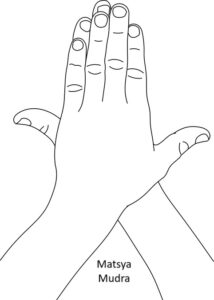Matsya Mudra
Introduction
Matsya Mudra is a sacred yogic hand gesture inspired by the symbolism of the fish (Matsya), which is considered the first incarnation of Lord Vishnu. In yogic and meditative practices, Matsya Mudra is associated with fluidity, adaptability, and the life-sustaining energy of water. It helps improve circulation, calm the mind, and bring emotional stability.
This mudra is especially beneficial for balancing the water element (Jala Tattva) in the body and enhancing vitality. It is commonly used in Prana Mudra Therapy, meditation, and Ayurveda-based healing.
Meaning
Matsya = Fish (symbol of flow, adaptability, and sustenance).
The mudra symbolizes the sustaining force of life and the ability to navigate through challenges with ease, just as a fish moves smoothly in water.
Energetically, it connects with Swadhisthana (Sacral) Chakra and Apana Vayu (downward energy).
How to Perform (Practice)
Sit in Padmasana, Sukhasana, or Vajrasana with spine straight and shoulders relaxed.
Place your right palm flat against the back of your left hand. Extend your thumbs to the sides and bring your other fingers together.
Spread the palms outward and angle the hands so that they resemble the shape of a fish.
Close the eyes and breathe deeply, focusing on fluid breath and calm awareness.
Practice for 5–15 minutes, once or twice daily.
Benefits
Physical Benefits
Improves blood circulation and oxygen supply.
Strengthens the lungs and respiratory system.
Supports the urinary and reproductive system by balancing water element.
Relieves fatigue, lethargy, and mild body aches.
Mental & Emotional Benefits
Enhances emotional flexibility and adaptability.
Reduces anxiety, stress, and restlessness.
Promotes peaceful sleep and relaxation.
Increases ability to flow with life situations calmly.
Spiritual Benefits
Activates Swadhisthana (Sacral Chakra) – seat of emotions, creativity, and flow.
Connects practitioner with Lord Vishnu’s sustaining energy.
Encourages surrender and trust in the cosmic flow of life.
Promotes meditative awareness and inner stillness.
Contraindications
Avoid prolonged practice during severe cold, cough, or asthma attacks.
Those with excess water retention (edema) should practice moderately.
Not advised immediately after heavy meals.
Individuals with low blood pressure should be cautious.
Anatomy & Physiology
Activates the respiratory diaphragm, promoting deep breathing.
Stimulates the parasympathetic nervous system, inducing relaxation.
Improves functioning of kidneys and bladder, regulating water balance.
Supports endocrine system, especially adrenal glands and gonads.
Kinesiology
Crossing of thumbs and spreading palms engages thenar and hypothenar muscles of the hands.
Involves flexor digitorum muscles for interlacing stability.
Creates awareness in shoulder girdle muscles by holding posture in front of chest.
Promotes kinesthetic sense of fluid movement and flexibility.
Neurology
Stimulates brain regions associated with emotional regulation and adaptability.
Enhances neuroplasticity by calming repetitive stress circuits.
Engages the prefrontal cortex, improving decision-making and problem-solving.
Promotes parasympathetic activation, balancing the nervous system.
Duration of Practice
Beginners: 5 minutes once daily.
Intermediate: 10–15 minutes twice daily.
Advanced: Up to 30 minutes during meditation, pranayama, or relaxation.
Best times: Morning (for clarity) and Evening (for relaxation).
Counter Mudra
Prithvi Mudra – to ground excess water energy.
Vayu Mudra – to balance movement and reduce sluggishness.
Dhyana Mudra – for centering after fluid and expansive energy of Matsya Mudra.
Conclusion
Matsya Mudra is a gentle yet powerful mudra that embodies the fluidity and adaptability of the fish. By balancing the water element, it improves circulation, calms the mind, and harmonizes emotions. Spiritually, it deepens meditation and supports surrender to the universal flow. A perfect mudra for those seeking calmness, emotional stability, and spiritual grounding.
FAQ
Q1. Which element does Matsya Mudra balance?
It balances the water element (Jala Tattva).
Q2. Can Matsya Mudra help in insomnia?
Yes, it calms the mind and promotes peaceful sleep.
Q3. Is it safe for pregnant women?
Yes, if practiced gently under guidance, it supports emotional balance.
Q4. Can children practice Matsya Mudra?
Yes, for 3–5 minutes, especially to calm hyperactivity.
Q5. Can it be combined with pranayama?
Yes, especially with Anulom Vilom or Ujjayi breathing.
References
Swami Satyananda Saraswati – Asana, Pranayama, Mudra, Bandha.
Gertrud Hirschi – Mudras: Yoga in Your Hands.
Vasant Lad – The Yoga of Herbs.
David Frawley – Ayurveda and the Mind.
Peer-reviewed articles on mudra therapy, water element balance, and autonomic regulation.

